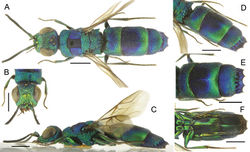Chrysis splendidula
| Notice: | This page is derived from the original publication listed below, whose author(s) should always be credited. Further contributors may edit and improve the content of this page and, consequently, need to be credited as well (see page history). Any assessment of factual correctness requires a careful review of the original article as well as of subsequent contributions.
If you are uncertain whether your planned contribution is correct or not, we suggest that you use the associated discussion page instead of editing the page directly. This page should be cited as follows (rationale):
Citation formats to copy and paste
BibTeX: @article{Rosa2021JournalofHymenopteraResearch84, RIS/ Endnote: TY - JOUR Wikipedia/ Citizendium: <ref name="Rosa2021Journal of Hymenoptera Research84">{{Citation See also the citation download page at the journal. |
Ordo: Hymenoptera
Familia: Chrysididae
Genus: Chrysis
Name
Chrysis splendidula species group – Wikispecies link – Pensoft Profile
- Chrysis splendidula group: Linsenmaier 1959[1]: 124 (key), 127 (diagn.). Kimsey and Bohart 1991: 328 (key), 362 (diagn.).
- Chrysis splendidula s.str. subgroup: Kimsey and Bohart 1991: 332 (key), 362 (diagn.).
- Chrysis serpentula group: Tarbinsky 2002[2]: 18 (diagn.), syn. nov.
Diagnosis
The splendidula species group includes Palaearctic species recognizable by the last metasomal tergum which is coloured blue or green, usually contrasting with metasomal terga I–II which are red. However, exceptions to this colouration pattern are five Central Asian species with terga I–II blue or blue with green to light blue stripes (Chrysis centralis Semenov-Tian-Shanskij, 1967; C. circassica Mocsáry, 1893; C. hyacinthus Semenov-Tian-Shanskij, 1967; C. kokandica Radoszkowsky, 1877; C. serpentula Semenov-Tian-Shanskij, 1967) and a Japanese one (C. nohirai Tsuneki, 1952).
Members of the splendidula species group can be recognised by the combination of the following characters: transverse frontal carina distinct and raised; apical margin of metasomal tergum III with four sharp teeth, and black spots on sternum II elongate, connected to lateroterga and widely separated in the middle (Fig. 1F).
Description
Face with distinct and raised transverse frontal carina, M-like or biconvex, recurved below; scapal basin medially polished to finely wrinkled; malar spaces usually 1.0–1.5 × MOD; second flagellomere usually slightly shortened; carina on metasomal tergum II indistinct or as an impunctate line, rarely raised and sharp; tergum III with distinct row of small, round to slightly elongate pits; apical margin of tergum III with four sharp, triangular teeth; black spots on sternum II widely separated and elongate, adjacent to lateral margin.
Hosts
Vespidae: Eumeninae (Martynova and Fateryga 2015[3]).
Remarks
Kimsey and Bohart (1991) subdivided the splendidula species group into two subgroups: the splendidula s.str. subgroup and the splendidula-senegalensis subgroup. We here consider these two groups as separated because of the different shape of female internal terga that form the telescopic ovipositor (Rosa et al., in preparation).
Chrysis arkadyi sp. nov. is the only known member of the splendidula group from India and Pakistan so far. Conversely, four species of the senegalensis group are known for India (Rosa et al. 2021[4]), namely: Chrysis disparilis Cameron, 1897, C. hecate Mocsáry, 1889, C. ionophris Mocsáry, 1893, and C. sikkimensis Mocsáry, 1912.
Tarbinsky (2002)[2] established the serpentula species group, based on misidentified specimens of Chrysis serpentula Semenov-Tian-Shanskij, 1967. After type examination (Rosa et al. 2017[5], fig. 122) we include this species in the splendidula species group and we here synonymize the serpentula species group with the splendidula species group.
Taxon Treatment
- Rosa, P; Baiocchi, D; Halada, M; Proshchalykin, M; 2021: A new species and new records of cuckoo wasps from Pakistan and India (Hymenoptera, Chrysididae) Journal of Hymenoptera Research, 84: 283-294. doi
Images
|
Other References
- ↑ Linsenmaier W (1959) Revision der Familie Chrysididae (Hymenoptera) mit besonderer Brücksichtigung der europäischen Spezies.Mitteilungen der Schweizerischen Entomologischen Gesellschaft32: 1–232.
- ↑ 2.0 2.1 Tarbinsky Y (2002) The golden wasp genus Chrysis L. (Hymenoptera, Chrysididae) in Tien Shan and adjacent territories. II. Species groups succincta, leachii, cerastens (!), taczanovskii, pallidicornis, smaragdula, elegans, subsinuata, serpentula, facialis, maculicornis, millenaris.Entomologicheskie Issledovaniya v Kirgizii22: 11–22. [in Russian]
- ↑ Martynova K, Fateryga A (2015) Chrysidid Wasps (Hymenoptera, Chrysididae) – Parasites of Eumenine Wasps (Hymenoptera, Vespidae: Eumeninae) in Crimea.Entomological Review95(4): 472–485. https://doi.org/10.1134/S0013873815040090
- ↑ Rosa P, Aswathi P, Bijoy C (2021) The Indian cuckoo wasps (Hymenoptera: Chrysididae).Zootaxa4929(1): 1–100. https://doi.org/10.11646/zootaxa.4929.1.1
- ↑ Rosa P, Belokobylskij S, Zaytseva L (2017) The Chrysididae types described by Semenov-Tian-Shanskij and deposited at the Zoological Institute of the Russian Academy of Sciences, Saint-Petersburg (Insecta: Hymenoptera).Proceedings of the Zoological Institute RAS, Supplement5: 1–269.
